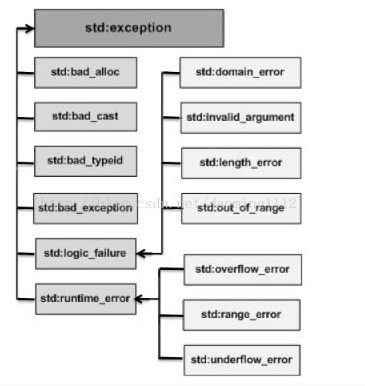一try-catch
1
2
3
4
5
6
| 信息汇总:
1、windows上可以扩展捕获SEGV异常的实现; linux标准C++上没有
windows: https://www.codeproject.com/Articles/207464/Exception-Handling-in-Visual-Cplusplus
2、linux上实现捕捉信号的方式
(1)main-> setjump -> signal_handle ->longjump ->catch
(2) signal -> signale_handle -> throw err ->catch//不推荐
|
1 try-catch segv:
1
2
3
| 1) 基本上是基于setjump和longjump和信号处理函数实现。
2) 将信号转化为异常,注册信号处理函数,Throw SIGERR
|
1)基本上是基于setjump和longjump和信号处理函数实现。
1
2
3
4
5
6
7
| https://www.xspdf.com/resolution/52100043.html
C++ try-catch crash
C++ catching all exceptions, try{ // } catch () { // } will catch all C++ exceptions, but it should be considered bad design. You can use c++11's new current_exception mechanism, but if you don't Someone should add that one cannot catch "crashes" in C++ code. A try-catch-finally block is made up of the following sections: Any code that may throw an exception is placed inside the try block. If an exception is thrown, the catch block is entered, and the program can do the appropriate operation to recover or to alert the user.
Catch Segmentation fault in c++, Errors like segmentation faults are lower-level, and try-catch ignores these The appropriate thing to do is not to handle the crash like you would an This process in C++ is much easier than C, for example new throw an c++ try-catch crash-reports. share | improve this question | follow | | | | edited Nov 27 '14 at 4:17. paisanco. 3,631 6 6 gold badges 23 23 silver badges 30 30
catch() is not catching an exception, my program is still crashing , block is not catching errors maybe it is because of a Windows error. Windows defines in a C-style fashion - this is because Win32 was written in C both C++ exception handing and SEH perhaps you could try the following Both C and C++ programs can use the structured exception handling (SEH) mechanism in the Windows operating system. The concepts in SEH resemble those in C++ exceptions, except that SEH uses the __try, __except, and __finally constructs instead of try and catch. In the Microsoft C++ compiler (MSVC), C++ exceptions are implemented for SEH.
|
1
2
3
4
5
6
| https://github.com/printfn/segfaulting
通过setjump和longjump捕捉SEGV后跳转。 // 这个应该不是我们需要的
void catch_segfault(int signal, siginfo_t *si, void *arg) {
printf("Caught segfault at address %p (%zu)\n", si->si_addr, (size_t)si->si_addr);
longjmp(env_buffer, 1);
}
|
1
2
| https://blog.csdn.net/kongxiangwang/article/details/8237384?utm_medium=distribute.pc_relevant_bbs_down.none-task-blog-baidujs-2.nonecase&depth_1-utm_source=distribute.pc_relevant_bbs_down.none-task-blog-baidujs-2.nonecase
//windows上有对应的try-catch 扩展来捕获异常访问。
|
1
2
| https://blog.csdn.net/jekenzhuang/article/details/79737147?utm_medium=distribute.pc_relevant_bbs_down.none-task--2~all~first_rank_v2~rank_v29-2.nonecase&depth_1-utm_source=distribute.pc_relevant_bbs_down.none-task--2~all~first_rank_v2~rank_v29-2.nonecase
//try-catch流程
|
2)将信号转化为异常,注册信号处理函数,Throw SIGERR
1
2
3
4
| //注册信号处理函数, Throw error
https://www.jianshu.com/p/4e14ba11fe78
//但是sun的手册不建议 信号处理函数中抛出异常。
https://docs.oracle.com/cd/E19205-01/820-1214/bkahb/index.html
|
2、C++标准的异常
https://blog.csdn.net/daoming1112/article/details/54973549
表是对上面层次结构中出现的每个异常的说明:
| 异常 |
描述 |
| std::exception |
该异常是所有标准 C++ 异常的父类。 |
| std::bad_alloc |
该异常可以通过 new 抛出。 |
| std::bad_cast |
该异常可以通过 dynamic_cast 抛出。 |
| std::bad_exception |
这在处理 C++ 程序中无法预期的异常时非常有用。 |
| std::bad_typeid |
该异常可以通过 typeid 抛出。 |
| std::logic_error |
理论上可以通过读取代码来检测到的异常。 |
| std::domain_error |
当使用了一个无效的数学域时,会抛出该异常。 |
| std::invalid_argument |
当使用了无效的参数时,会抛出该异常。 |
| std::length_error |
当创建了太长的 std::string 时,会抛出该异常。 |
| std::out_of_range |
该异常可以通过方法抛出,例如 std::vector 和 std::bitset<>::operator。 |
| std::runtime_error |
理论上不可以通过读取代码来检测到的异常。 |
| std::overflow_error |
当发生数学上溢时,会抛出该异常。 |
| std::range_error |
当尝试存储超出范围的值时,会抛出该异常。 |
| std::underflow_error |
当发生数学下溢时,会抛出该异常。 |
3、自定义异常
